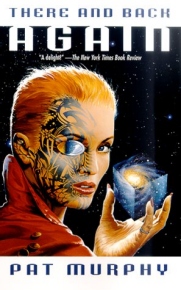ICYMI: From the Attic II: Pat Murphy
As we noted last month, we will be republishing noted critic and reviewer Kev McVeigh’s ‘From the Attic’ columns over the comiong weeks, to give new readers the opportunity to encounter his sage observations on some very important and all-too-often overlooked authors . . .
Pat Murphy says her favourite bird is the mockingbird because ‘it never sings the same song twice.’ So far the same can be said of Murphy herself. Some writers find a genre seam and mine it successfully (and some exhaust it sooner than they realise) but Pat Murphy has spent her career questing around the edges of genres often probing in multiple directions at once. It’s an approach made explicit in the title of her first collection Points Of Departure, but most obvious in her strange, brilliant novel Adventures In Time & Space With Max Merriwell. Along the way she has picked up a string of Hugo, Nebula, Locus and Philip K Dick Award nominations. Despite this variation, there are consistent aspects to her fiction that reward her fans richly.
As Emma Bull said:
Pat Murphy’s stories make me look at the world around me, blink, and look again. See what’s there, they say. See what could be there. See what isn’t there, but should be, what must never be there and is.
That’s the thing I love about many of Pat Murphy‘s stories: her protagonists don’t blink in the face of the fantastic but openly engage with it. Elizabeth Butler is not threatened by the Mayan ‘ghosts’ she sees in The Falling Woman. Jennifer in ‘About Fairies’ assumes that fairies exist because why wouldn’t they? And Mrs Jenkins knows that ‘A Falling Star Is A Rock From Outer Space’ but is also able to accept that her falling star is more than that. It is this equipoise that allows the artists of The City, Not Long After to use imagination to defeat an enemy unable to see beyond imagination.
That liminality, the way Murphy rather than have a foot in fantasy and a foot in reality actually crosshatches them, is something rare in SFF. She doesn’t straddle genres but melds them. There And Back Again for instance, sort of looks like The Hobbit retold as a steampunk space opera version of The Hunting Of The Snark with feminism, pataphysics, and a knowing cleverness that adds bite to its amiable charm. On the other hand Adventures In Time & Space With Max Merriwell is a romantic murder thriller on a Love Boat avatar in the Bermuda triangle all explained by quantum mechanics. And a direct sequel to There And Back Again and to Wild Angel the story of a young woman brought up by wolves in gold rush California. There And Back Again we are told, is actually written by somebody called Max Merriwell.
Wild Angel credits a Mary Maxwell, and in Adventures we meet a third Murphy pseudonym, thriller writer Weldon Merrimax. In what I want to call hyperphery Murphy has one of her pseudonyms as a ‘real’ character whilst the other two are both real and illusory, carried over from the earlier books and jousting for pre-eminence, meanwhile a character called Pat Murphy (there’s also a Patrick) resolves things with scientific explanations straight from the real Pat Murphy‘s work at the San Francisco science museum The Exploratorium. Then the wolves appear . . . clearly Murphy is having fun and so does her reader.
 Earlier in her career, the Nebula award-winning The Falling Woman (now reprinted as a Fantasy Masterwork) approaches time in the same manner. On an archaeological dig in the Yucatan Elizabeth Butler (a rare middle-aged woman protagonist in SFF) sees a woman from a 1000 years ago and the woman can see Elizabeth. Murphy uses this to debunk a few misconceptions about Mayans, about women, and as these misconceptions are Anglo-American in origin, by doing so she ultimately neatly punctures some of white America’s myths about itself. Confused? You won’t be. It’s a charming, poignant, wistful book and an important one too.
Earlier in her career, the Nebula award-winning The Falling Woman (now reprinted as a Fantasy Masterwork) approaches time in the same manner. On an archaeological dig in the Yucatan Elizabeth Butler (a rare middle-aged woman protagonist in SFF) sees a woman from a 1000 years ago and the woman can see Elizabeth. Murphy uses this to debunk a few misconceptions about Mayans, about women, and as these misconceptions are Anglo-American in origin, by doing so she ultimately neatly punctures some of white America’s myths about itself. Confused? You won’t be. It’s a charming, poignant, wistful book and an important one too.
 American myths of the need and the desire to rebuild America post-holocaust are prominent in SF, and at the time of Murphy’s third novel, The City, Not Long After were a popular trend. (Think David Brin‘s The Postman for instance.) I hope it’s not considered derogatory to label The City, Not Long After as a novel that could only have been told about California and about San Francisco. It has a free spirited imagination and a glorious non-violent response to military aggression (see also Murphy’s friend Lisa Goldstein‘s equally brilliant A Mask For The General) that fits perceptions of that city perfectly. It may sound twee, but Murphy’s ideas influenced by the likes of Stelarc are intriguing, bringing art and technology together in social contexts and she is realist enough to offer a truly shocking ending.
American myths of the need and the desire to rebuild America post-holocaust are prominent in SF, and at the time of Murphy’s third novel, The City, Not Long After were a popular trend. (Think David Brin‘s The Postman for instance.) I hope it’s not considered derogatory to label The City, Not Long After as a novel that could only have been told about California and about San Francisco. It has a free spirited imagination and a glorious non-violent response to military aggression (see also Murphy’s friend Lisa Goldstein‘s equally brilliant A Mask For The General) that fits perceptions of that city perfectly. It may sound twee, but Murphy’s ideas influenced by the likes of Stelarc are intriguing, bringing art and technology together in social contexts and she is realist enough to offer a truly shocking ending.
At shorter length Murphy’s body of short fiction collected in Points Of Departure is so good that it became not only the only collection to win the Philip K Dick Award but the only one ever shortlisted to date. Here are tales of ‘The Women In The Trees’ a simple tale of an unhappy wife’s escape made powerful by second-person telling; of a dead young woman whose identity is transplanted into a chimpanzee in the unforgettable Nebula winner ‘Rachel In Love’; of a man planting ‘His Vegetable Wife’ from a seed which Karen Joy Fowler called a ‘nasty’ story; and those people who live between realities ‘On The Dark Side Of The Station Where The Train Never Stops.’ There are fantasies, straight SF, twists upon classic tropes and remarkable new ideas told mostly without flash but a crystalline core that sustains the visionary surrounds.
Although each of Pat Murphy‘s works are so different from each other, and in many ways different from any other SFF around, they resemble genre works in ways that make them instantly recognisable. At the same time their liminality, the deeply embedded crosshatching of time streams, of genres, of realities, of characters, challenges our worldviews the way SFF is supposed to do. Occasionally I’m tempted to say that the layers of Murphy’s storying mean that even individual stories don’t always look like themselves. Take how the romantic comedy of Adventures In Time & Space is really a serious depiction of quantum mechanics, or a tense thriller. “Each of us looks for patterns in his own way.” Elizabeth Butler  writes in The Falling Woman and later “A society defines what is normal and what is crazy – and then says anyone who challenges the definition is crazy . . . Each culture defines its idiosyncrasies and then forgets that it has done so.” Pat Murphy is our perfect crazy-normal reminder that our patterns change as we change and we can leave them behind to create new ones or indeed that they need not be consecutive patterns but concurrent. Elizabeth does this with the return of her daughter into her life; Pat Murphy the character imposes the patterns of quantum physics upon the fictional characters around her (and in doing so tells us she knows it is a pattern i.e. fiction.); Bailey Beldon may go There And Back Again in a pre-established pattern from Tolkien, but his pattern is equally Carroll’s Snark and Campbell’s Hero; and the irony is of course that they are all Pat Murphy‘s patterns.
writes in The Falling Woman and later “A society defines what is normal and what is crazy – and then says anyone who challenges the definition is crazy . . . Each culture defines its idiosyncrasies and then forgets that it has done so.” Pat Murphy is our perfect crazy-normal reminder that our patterns change as we change and we can leave them behind to create new ones or indeed that they need not be consecutive patterns but concurrent. Elizabeth does this with the return of her daughter into her life; Pat Murphy the character imposes the patterns of quantum physics upon the fictional characters around her (and in doing so tells us she knows it is a pattern i.e. fiction.); Bailey Beldon may go There And Back Again in a pre-established pattern from Tolkien, but his pattern is equally Carroll’s Snark and Campbell’s Hero; and the irony is of course that they are all Pat Murphy‘s patterns.
‘About Fairies’ one of Murphy’s most recent stories, sums much of this up for me.
“My name is Jennifer. I am on my way to a toy company in Redwood City to have a meeting about fairies.” For Jennifer though the fairies are not the Disneyfied Tinkerbelles with pink dresses and sparkles but dark, amoral or even malevolent. “Tiffany’s fairies drink dewdrops and sip nectar from flowers. Mine prefer protein.” They may also be real or a virtual creation. A child’s imagination or a means of facing death. “People believe what they want to believe” Jennifer says at one point. Pat Murphy, ultimately, offers us not merely a choice of truths. Most authors do that. She offers us truths we have not seen previously and she shows how those truths co-exist, often uneasily but symbiotically. She writes serious feminist Fantasy that is also charming funny romantic SF at the same time as it is gripping thriller and even absorbing science demonstrations. You may learn from them or just enjoy them . . . I did both.
**********
You can find many of the titles mentioned above via Pat Murphy’s author page on the SF Gateway, and read more about her in her entry in The Encyclopedia of Science Fiction.
This post was originally published 19th November 2013.


